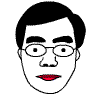This example shows how to curve-bend an label stuck on a cylindrical surface to rectangular area.
- Save the following Python-fu script to C:\Program Files\GIMP
2\lib\gimp\2.0\plug-ins\my_curve_bend.py
(Assume GIMP is installed in C:\Program Files\GIMP 2)
Note that the pdb.plug_in_curve_bend() is used.
- Open the sample label in GIMP.

- Goto Menu Windows -> New Toolbar. Double click the "Path" toolbar

- Draw a upper path along the curved surface. Please use maximum 16 segments.
(Note you can use Ctrl + Mouse scroll to zoom-in)

- Press the Shift key to start a new path segment.
Draw a lower path along the curved surface. Please use maximum 16 segments.

- Start the bending by go to Menu Python-fu -> My curve bend.
Here is the result:

- You can hide away / delete other layers by: Menu Windows -> Dockable Dialogue -> Layers
And delete the layers

- The original image layer was removed. Note the red line showing the original
image was bent according to mirror of the upper and lower path.

- The image was cropped and the result image:
 ->
->

| #!/usr/bin/env python from gimpfu import * from array import array def my_curve_bend(image, drawable) : pdb.gimp_message('my_curve_bend') # Please plot the upper path from left to right. # then press shift # then plot the lower path from left to right. cur_image = gimp.image_list()[0]; cur_layer = cur_image.layers[0]; # get the points of upper path and lower paths. # Note that: with gimp_vectors_stroke_get_points, the vectors has control points, center and control points. # some code is added to extract only the center points. active_vectors = pdb.gimp_image_get_active_vectors(cur_image) nstrokes, strokes = pdb.gimp_vectors_get_strokes(active_vectors) upper_type, upper_num_points, upper_controlpoints, upper_closed = pdb.gimp_vectors_stroke_get_points(active_vectors, strokes[0]) lower_type, lower_num_points, lower_controlpoints, lower_closed = pdb.gimp_vectors_stroke_get_points(active_vectors, strokes[1]) upper_point_x_s = array('d', []) for i in xrange(2,len(upper_controlpoints),6): upper_point_x_s.append(upper_controlpoints[i]) upper_point_y_s = array('d', []) for i in xrange(3,len(upper_controlpoints),6): upper_point_y_s.append(upper_controlpoints[i]) lower_point_x_s = array('d', []) for i in xrange(2,len(lower_controlpoints),6): lower_point_x_s.append(lower_controlpoints[i]) lower_point_y_s = array('d', []) for i in xrange(3,len(lower_controlpoints),6): lower_point_y_s.append(lower_controlpoints[i]) # calculate the bounding rectangle and make selection top_l_x = upper_point_x_s[0]; top_l_y = upper_point_y_s[0]; top_r_x = upper_point_x_s[len(upper_point_x_s)-1]; top_r_y = upper_point_y_s[len(upper_point_y_s)-1]; btm_l_x = lower_point_x_s[0]; btm_l_y = lower_point_y_s[0]; btm_r_x = lower_point_x_s[len(lower_point_x_s)-1]; btm_r_y = lower_point_y_s[len(lower_point_y_s)-1]; bb_x = min(upper_point_x_s + lower_point_x_s) bb_y = min(upper_point_y_s + lower_point_y_s) bb_w = max(upper_point_x_s + lower_point_x_s) - bb_x bb_h = max(upper_point_y_s + lower_point_y_s) - bb_y pdb.gimp_rect_select( cur_image, # image \ bb_x, # x \ bb_y, # y \ bb_w, # width \ bb_h, # height \ 0, # operation \ 0, # feather \ 0 # feather_radius \ ) # calculate the bending curve mirrored. top_avg_y = (top_l_y + top_r_y)/2.0 btm_avg_y = (btm_l_y + btm_r_y)/2.0 top_len = (top_r_x - top_l_x) btm_len = (btm_r_x - btm_l_x) upper_point_x_s_final = [ (x - top_l_x) / top_len for x in upper_point_x_s] upper_point_y_s_final = [ 0.5 + ((y-top_avg_y) / (1.0 * top_len)) for y in upper_point_y_s] lower_point_x_s_final = [ (x - btm_l_x) / btm_len for x in lower_point_x_s] lower_point_y_s_final = [ 0.5 + ((y-btm_avg_y) / (1.0 * btm_len)) for y in lower_point_y_s] upper_val_y_s = array('b', []) lower_val_y_s = array('b', []) bent_layer = pdb.plug_in_curve_bend(\ cur_image # image \ , cur_layer # drawable \ , 0.0 # rotation \ , TRUE # smoothing \ , TRUE # antialias \ , TRUE # work_on_copy \ , 0 # curve_type \ , len(upper_point_x_s_final) # argc_upper_point_x \ , upper_point_x_s_final # upper_point_x \ , len(upper_point_y_s_final) # argc_upper_point_y \ , upper_point_y_s_final # upper_point_y \ , len(lower_point_x_s_final) # argc_lower_point_x \ , lower_point_x_s_final # lower_point_x \ , len(lower_point_y_s_final) # argc_lower_point_y \ , lower_point_y_s_final # lower_point_y \ , len(upper_val_y_s) # argc_upper_val_y \ , upper_val_y_s # upper_val_y \ , len(lower_val_y_s) # argc_lower_val_y \ , lower_val_y_s # lower_val_y \ ); pdb.gimp_layer_set_visible(bent_layer, TRUE) return # This is the plugin registration function # I have written each of its parameters on a different line register( #Your plugin's main function name, as it will be found in Gimp's Procedure Browser. #This means that your plugin will be callable by other plugins, using this function #name (even by a script in a another language)! "my_curve_bend", #Your plugin's "documentation" name, as it will also appears in the Procedure Browser. #This name should describe your plugin briefly. "My Curve Bend Python-Fu", #Plugin's help. Here you should explain in a more detailed manner what kind of function #your plugin provides. "This script does the reverse of curve bending", #The name of the author of this plugin "Y Lam", #Any copyright information needed "Y Lam", #The date this version of the plugin was released "Sep 2014", #The path in the menu where your plugin should be found "<Image>/Python-Fu/My Curve Bend", #The image types supported by your plugin "*", #The list of the parameters needed by your plugin [], #The results sent back by your plugin [], #The name of the local function to run to actually start processing, which will be called with a set of parameters. my_curve_bend, ) main() |

沒有留言:
張貼留言